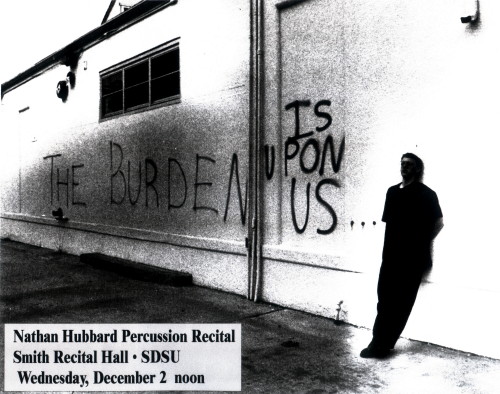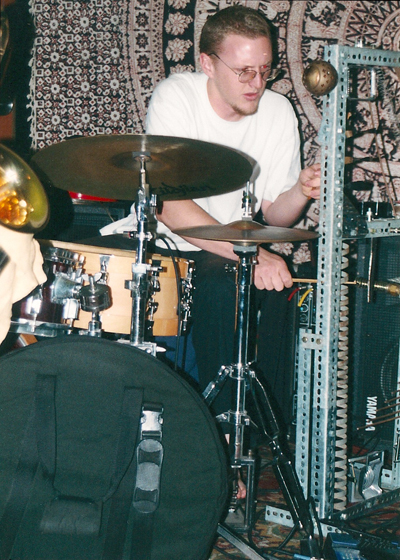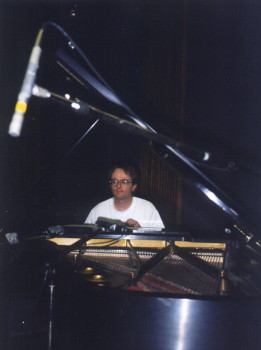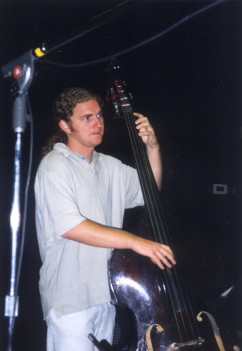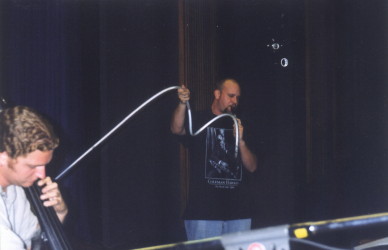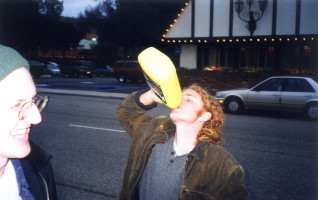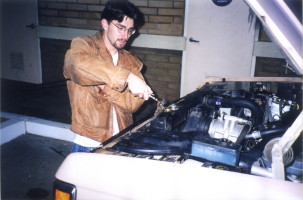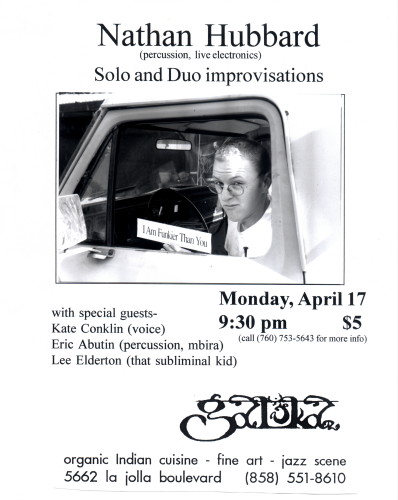|
Nathan Hubbard interviews Nathan Hubbard
about the quartet Return To One (Fall 2000)
NH: Return To One originally was a trio, if I'm not mistaken…
nh: You are mistaken. RTO was originally a sextet that was formed in
high school (1992). Slowly, as band members left for college or found
other interests, the band found a firm foundation as a quartet (Roger
Riedlbauer/guitar, Stephane Ryder/piano, Bruce Grafrath/bass and Nathan
Hubbard/drums). After Stephane left for Harvard, we survived for several
years as a trio (guitar, bass, and drums). After Roger left for San
Francisco, we functioned as a trio (with the addition of Lee Elderton,
saxophone) with Bruce Grafrath originally playing bass, and soon after
Josh Jones taking over that chair. As a sax trio we worked for several
years (1996-1999) until the recent addition of Ward Baxter.
NH: What were you playing as a trio?
nh: We started out playing jazz standards. The trio was the first time
I ever felt completely comfortable with two other musicians. Since I
was happy with musical matters (time, feel, intonation and so forth)
I felt it necessary to continue pushing our boundaries.
NH: What do you mean?
nh: In earlier versions of the band we had always experimented with
extended forms, playing free, different feels and many other concepts.
I felt that all these could be continued to work on as well as extending
our sonic vocabulary, finding new modes of interaction and many other
concepts that had come up in our playing and our studies.
NH: And you were doing this over standards?
nh: Yes. I vividly recall a spontaneous version of All The Things
You Are where Josh and I dropped to half-time, then modulated up
to six and finally back to atempo over the course of a chorus. Lee gave
us the look of death! I also remember playing Yesterdays one
night and Josh playing all sorts of harmonic anticipations and delays.
These, and many others, were concepts we were experimenting with and
adding to our vocabularies.
NH: Who were the influences at this time?
nh: Charles Mingus' bands with Dannie Richmond was a very big influence,
the way the rhythm section would lead the way. I can also clearly remember
the day I got Derek Baileys book. I immediately made Lee and Josh read
it. I know that Lee grew up with Phil Woods and similar players, and
at this time he was getting into Ornette Coleman, Eric Dolphy, Anthony
Braxton and such. But you would really have to ask him. With Josh, I
have no idea. I know he listens to everything from Jaco to Richard Davis
to Jonas Hellborg to Sting. Again, you are going to have to ask him.
Personally, I was still very much into Tony Williams, Paul Motion, Elvin
Jones, and Jack DeJohnette but also starting to listen to more Europeans
(Tony Oxley, Han Bennink, Paul Lytton) and the downtown scene (Masada,
Bloodcount, Barondown, etc...).
NH: When did your compositions become a focal point?
nh: Earlier versions of the band had played several of my tunes, but
the first tune I was happy with was one rainy night. The solo
section for this was originally a G locrain vamp, but ended up as an
open improvising territory. This opened many new playing (and compositional)
concepts for us as a band. I was still writing quite a few tunes that
were trying to sound like standards. Around this time I dropped that
concept and really began to work on what I was hearing in my head. For
a while we mixed these tunes in with standards, until about the time
we released the first CD, by which time we had band books and were playing
my compositions almost exclusively.
NH: What was the concept behind promises (the first RTO CD)?
nh: My great-grandmother (Stella Hubbard) was an incredible painter/artist.
Around this time I had purchased a Pete LaRoca CD intitled Turkish Woman
at the Bath. As you might know, the compositions on this CD were all
inspired by a painting by Jean Auguste Dominique Ingres. I thought that
if Pete can write a record around a painting, why can't I? So I started
writing these tunes. I believe blurred image was first, but they
all got done. Each composition corresponds to a painting, or in the
case of promises, about my feeling surrounding the paintings.
We recorded the album twice, about a year apart. With that time, I was
able to revise several tunes, drop one tune, add three new tunes, and
ask Ward Baxter to play on the tunes I felt needed to be quartet. I
continue to write compositions based on these paintings. We have enough
new material to fill two more CDs.
NH: In recent years, there has been a growing trend of painters and
improvisers working together, say Tony Oxley and Alan Davies for example.
How did you go about bringing the two (painting and music) together?
nh: Well, many of these collaborations you are speaking about work in
a more give and take relationship. My situation was slightly different
in that my great-grandmother has past away, and I am composing compositions
as opposed to improvising exclusively. My thought was to bring out what
I found most interesting in these paintings. Take blurred image
for example. This painting is unfinished. However, what is there is
a blurred landscape of a coast and several boats. So this composition
uses extended harmonies and constantly changing time signatures to give
a sense of blurring. parabolic flower was a structured improvisation.
I was very interested in the timelessness of the painting and the proportions
of the flower to the background. in her garden was a statement
about the passing of time and the questions brought up by the painting-
namely, are her flowers still blooming? Because the flowers are blooming
in the painting. This was edited on to all is silent, which I
believe answers the previous tune. Each tune has a similar story.
NH: How did Ward Baxter enter the story?
nh: Ward was a close friend of the band (he went to school with Lee
and I). The three of us had played together in various ensembles, like
the Spectrum Quartet and the Neo-Modern Jazz Quintet. At this time I
was getting more interested in writing for two horns. It was the perfect
moment.
NH: Lately, I've been noticing that your toons are getting longer, as
well as the performances of these toons. Is this a direction you are
consciously going in?
nh: Yes. My first thought as a bandleader is to let the musicians play
how they want. I will tell them if I thing something does not work or
something we can work on more. But in general, our sound is the combination
of our interests and length of the compositions in a performance often
reflects that. I make this point because I hear a lot of people saying
that this is an academic approach we are taking or somehow that the
music is forced. This music is simply four musicians growing up together
and finding their own solutions instead of the solutions handed to them.
NH: This is very interesting, but you have not answered my question
at all.
nh: Sorry. Yes, the compositions are getting longer. This started with
silverfish (on Hopes and Dreams) and continues on through firecliffs
(not yet recorded), which is a forty-five minute piece. Lately I have
been writing more through-composed pieces as opposed to the conventional
head-solo-head format.
NH: Some of these pieces have their roots in other place, do they not?
nh: Well, a search for truth was originally written for wind
orchestra. I condensed the score down for quartet. Many of my smaller
pieces for other ensembles are now being used as modular pieces in any
open territory.
NH: And what about the new CD? (Hopes and Dreams)
nh: Hopes and Dreams was a chance to record a wide range of my
compositions not dealing with Stella's paintings. They range from high
school (solitary lines) to more recent (achieving). It
was also a chance to play with pianist Rick Helzer, who was kind enough
to record with us. I think this CD shows a wide array of what we have
been up to - playing time, not playing time, playing changes, not playing
changes, link structures, new harmonic concepts, odd times, free improvisation,
changing instrumental roles, the inclusion of poetry and many other
things.
|
